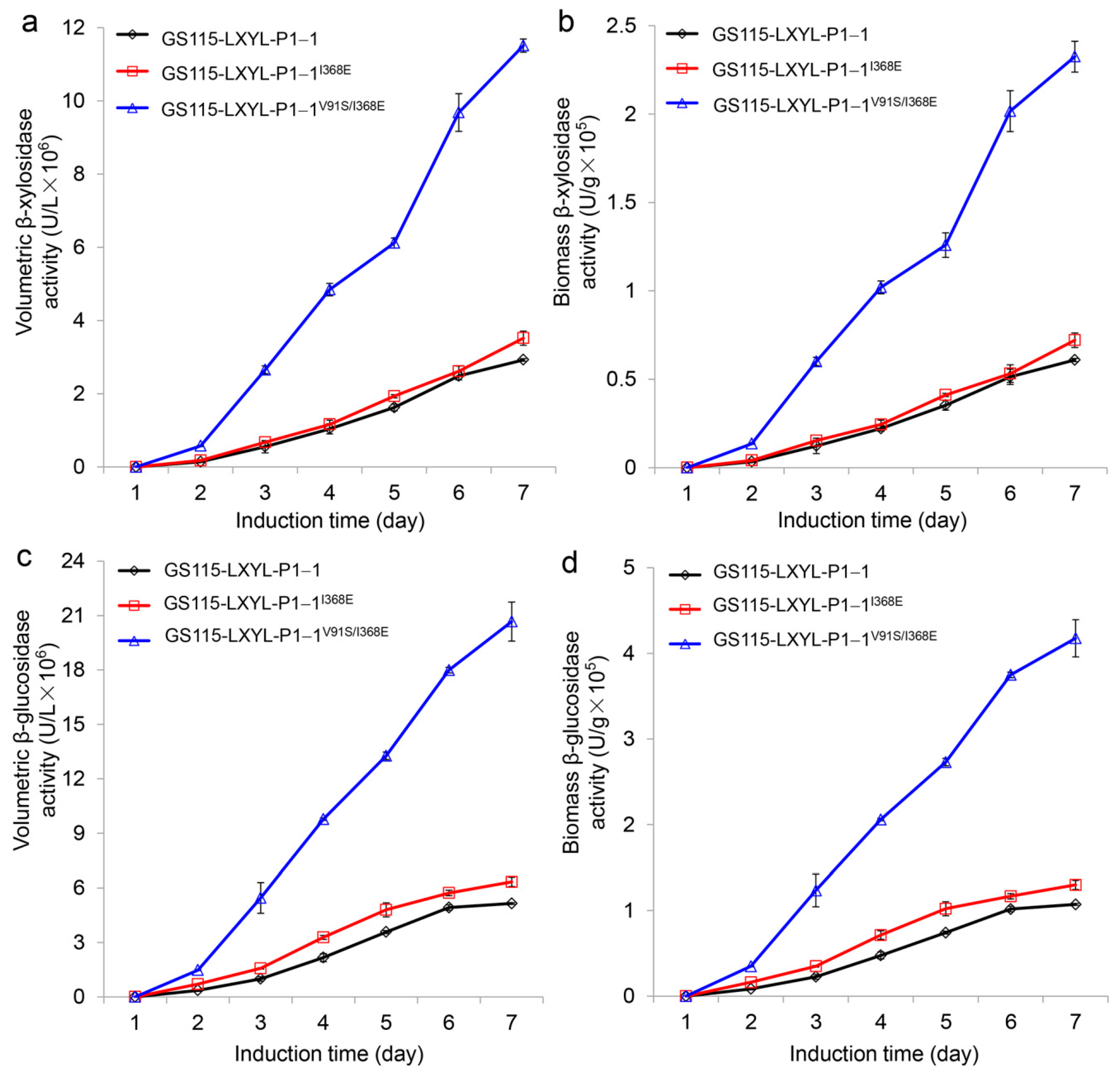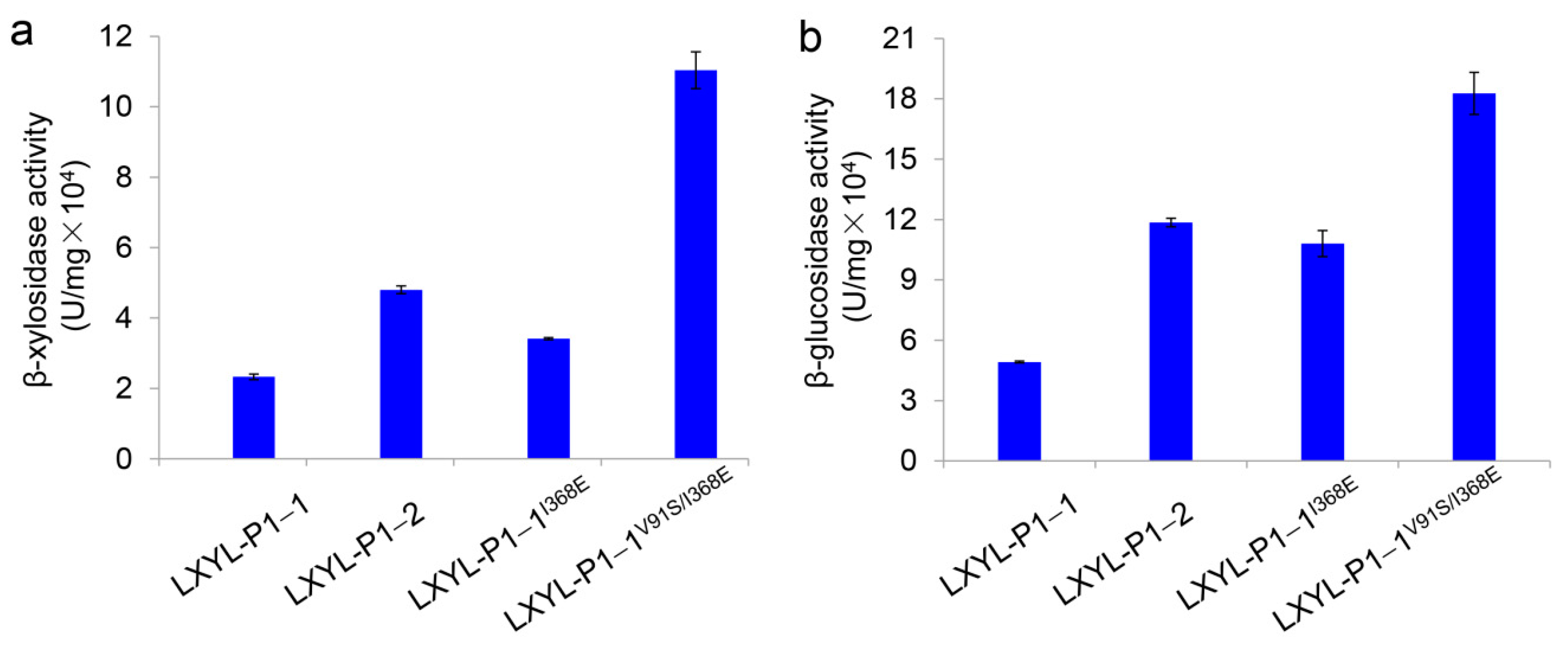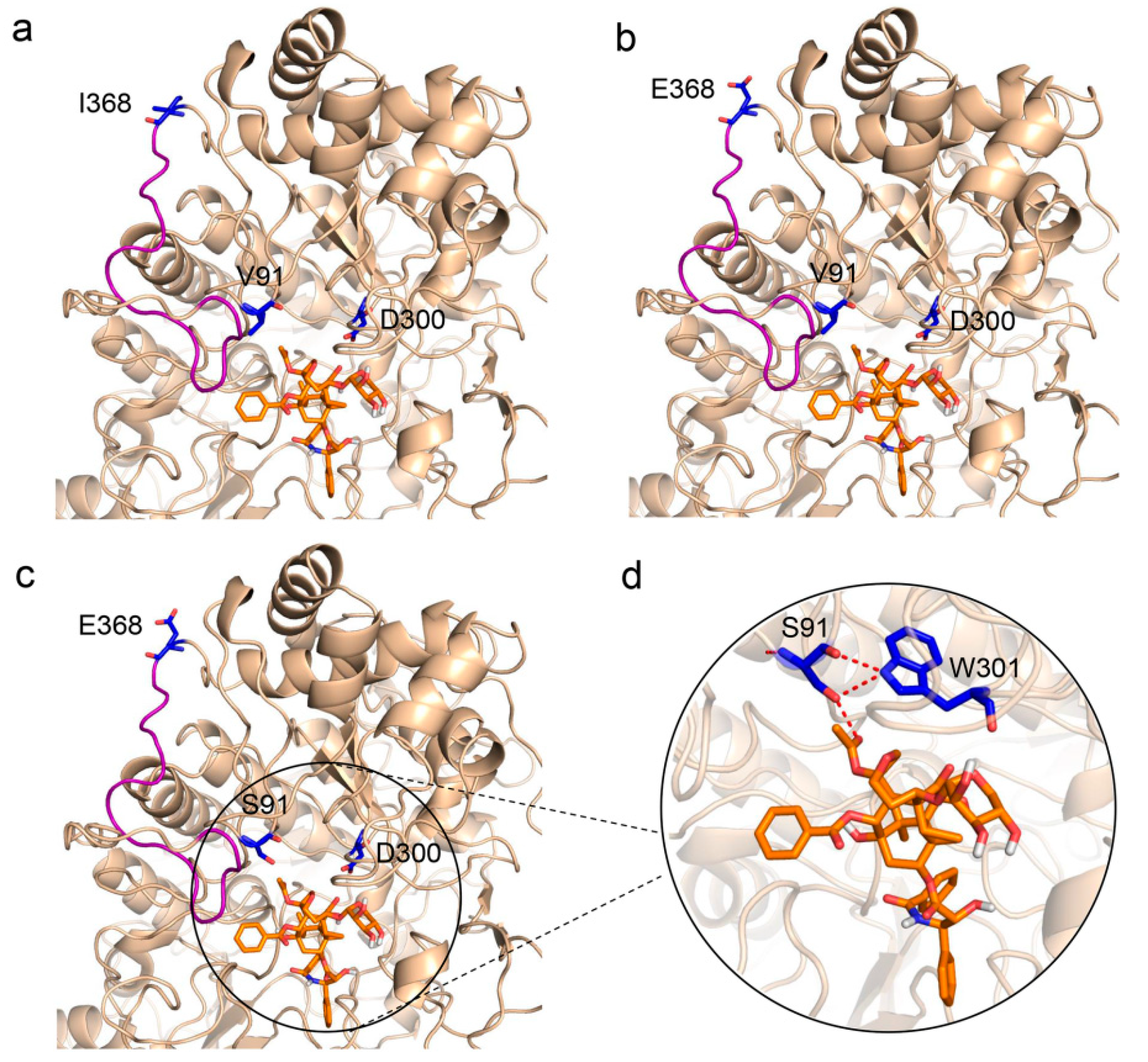Site-directed Mutagenesis of a β-Glycoside Hydrolase from Lentinula edodes
Abstract
:1. Introduction
2. Results and Discussion
2.1. The Volumetric and Biomass Enzyme Activities of the Recombinant Yeasts
2.2. Specific β-Xylosidase and β-Glucosidase Activities of the Mutants
2.3. Kinetic Analysis of the Mutated Enzymes against XDT
2.4. Substrate-Enzyme Molecular Docking
3. Materials and Methods
3.1. Plasmids and Strains
3.2. Construction of the Recombinant Plasmids Expressed lxyl-p1−1I368E and lxyl-p1−1V91S/I368E
3.3. Construction of the Recombinant Yeast Expressed lxyl-p1−1I368E and lxyl-p1−1V91S/I368E
3.4. Induction Protein Expression of LXYL-P1−1I368E and LXYL-P1−1V91S/I368E
3.5. Volumetric and Biomass Enzyme Activities Measurement of the Recombinant Yeasts
3.6. Enzyme Activities Measurement of LXYL-P1−1I368E and LXYL-P1−1V91S/I368E
3.7. Kinetic Study of LXYL-P1−1I368E and LXYL-P1−1V91S/I368E
4. Conclusions and Perspective
Author Contributions
Funding
Conflicts of Interest
References
- Choi, J.M.; Han, S.S.; Kim, H.S. Industrial applications of enzyme biocatalysis: Current status and future aspects. Biotechnol. Adv. 2015, 33, 1443–1454. [Google Scholar] [CrossRef] [PubMed]
- Kirk, O.; Borchert, T.V.; Fuglsang, C.C. Industrial enzyme applications. Curr. Opin. Biotech. 2002, 13, 345–351. [Google Scholar] [CrossRef]
- Lutz, S. Beyond directed evolution—semi-rational protein engineering and design. Curr. Opin. Biotech. 2010, 21, 734–743. [Google Scholar] [CrossRef] [PubMed] [Green Version]
- Denisenko, Y.A.; Gusakov, A.V.; Rozhkova, A.M.; Osipov, D.O.; Zorov, I.N.; Matys, V.Y.; Uporov, I.V.; Sinitsyn, A.P. Site-directed mutagenesis of GH10 xylanase A from Penicillium canescens for determining factors affecting the enzyme thermostability. Int. J. Biol. Macromol. 2017, 104, 665–671. [Google Scholar] [CrossRef] [PubMed]
- Fan, Y.; Fang, W.; Xiao, Y.; Yang, X.; Zhang, Y.; Bidochka, M.J.; Pei, Y. Directed evolution for increased chitinase activity. Appl. Microbiol. Biot. 2007, 76, 135–139. [Google Scholar] [CrossRef] [PubMed]
- van der Veen, B.A.; Potocki-Véronèse, G.; Albenne, C.; Joucla, G.; Monsan, P.; Remaud-Simeon, M. Combinatorial engineering to enhance amylosucrase performance: Construction, selection, and screening of variant libraries for increased activity. FEBS Lett. 2004, 560, 91–97. [Google Scholar] [CrossRef]
- Xu, M.; Zhang, R.; Liu, X.; Shi, J.; Xu, Z.; Rao, Z. Improving the acidic stability of a β-mannanase from Bacillus subtilis by site-directed mutagenesis. Process Biochem. 2013, 48, 1166–1173. [Google Scholar] [CrossRef]
- Wang, M.; Si, T.; Zhao, H.M. Biocatalyst development by directed evolution. Bioresource Technol. 2012, 115, 117–125. [Google Scholar] [CrossRef] [Green Version]
- Bornscheuer, U.T.; Pohl, M. Improved biocatalysts by directed evolution and rational protein design. Curr. Opin. Chem. Biol. 2001, 5, 137–143. [Google Scholar] [CrossRef]
- Dalby, P.A. Strategy and success for the directed evolution of enzymes. Curr. Opin. Struc. Biol. 2011, 21, 473–480. [Google Scholar] [CrossRef]
- Veno, J.; Ahmad Kamarudin, N.H.; Mohamad Ali, M.S.; Masomian, M.; Raja Abd Rahman, R.N.Z. Directed evolution of recombinant C-terminal truncated Staphylococcus epidermidis lipase AT2 for the enhancement of thermostability. Int. J. Mol. Sci. 2017, 18, 2202. [Google Scholar] [CrossRef] [PubMed]
- Wang, Y.; Feng, S.Y.; Zhan, T.; Huang, Z.Q.; Wu, G.J.; Liu, Z.D. Improving catalytic efficiency of endo-β-1,4-xylanase from Geobacillus stearothermophilus by directed evolution and H179 saturation mutagenesis. J. Biotechnol. 2013, 168, 341–347. [Google Scholar] [CrossRef] [PubMed]
- Zhang, Z.G.; Yi, Z.L.; Pei, X.Q.; Wu, Z.L. Improving the thermostability of Geobacillus stearothermophilus xylanase XT6 by directed evolution and site-directed mutagenesis. Bioresource Technol. 2010, 101, 9272–9278. [Google Scholar] [CrossRef] [PubMed]
- Stephens, D.E.; Rumbold, K.; Permaul, K.; Prior, B.A.; Singh, S. Directed evolution of the thermostable xylanase from Thermomyces lanuginosus. J. Biotechnol. 2007, 127, 348–354. [Google Scholar] [CrossRef] [PubMed]
- Li, H.X.; Zhu, P. Effect of the length of homologous sequence on the In-Fusion recombination efficiency. Chinese Med. Biotechnol. 2013, 8, 241–246. [Google Scholar]
- Li, B.J.; Wang, H.; Gong, T.; Chen, J.J.; Chen, T.J.; Yang, J.L.; Zhu, P. Improving 10-deacetylbaccatin III-10-β-O-acetyltransferase catalytic fitness for Taxol production. Nat. Commun. 2017, 8, 15544. [Google Scholar] [CrossRef] [PubMed]
- Han, C.; Li, W.; Hua, C.; Sun, F.; Bi, P.; Wang, Q. Enhancement of catalytic activity and thermostability of a thermostable cellobiohydrolase from Chaetomium thermophilum by site-directed mutagenesis. Int. J. Biol. Macromol. 2018, 116, 691–697. [Google Scholar] [CrossRef] [PubMed]
- Ayadi, D.Z.; Sayari, A.H.; Hlima, H.B.; Mabrouk, S.B.; Mezghani, M.; Bejar, S. Improvement of Trichoderma reesei xylanase II thermal stability by serine to threonine surface mutations. Int. J. Biol. Macromol. 2015, 72, 163–170. [Google Scholar] [CrossRef]
- Oh, E.J.; Lee, Y.J.; Chol, J.; Seo, M.S.; Lee, M.S.; Kim, G.A.; Kwon, S.T. Mutational analysis of Thermus caldophilus GK24 β-glycosidase: Role of His119 in substrate binding and enzyme activity. J. Microbiol. Biotech. 2008, 18, 287–294. [Google Scholar]
- Turek, D.; Klimeš, P.; Mazura, P.; Brzobohatý, B. Combining rational and random strategies in β-glucosidase Zm-p60. 1 protein library construction. PLoS ONE 2014, 9, e108292. [Google Scholar] [CrossRef]
- Wang, F.; Zhu, P. Prediction and preliminary functional analysis of the potential active center of the glycoside hydrolases LXYL-P1-1 and LXYL-P1-2. Mycosystema 2013, 32, 846–854. [Google Scholar]
- Pei, X.Q.; Yi, Z.L.; Tang, C.G.; Wu, Z.L. Three amino acid changes contribute markedly to the thermostability of β-glucosidase BglC from Thermobifida fusca. Bioresource Technol. 2011, 102, 3337–3342. [Google Scholar] [CrossRef] [PubMed]
- Yang, H.; Liu, L.; Shin, H.-D.; Chen, R.R.; Li, J.; Du, G.; Chen, J. Structure-based engineering of histidine residues in the catalytic domain of α-amylase from Bacillus subtilis for improved protein stability and catalytic efficiency under acidic conditions. J. Biotechnol. 2013, 164, 59–66. [Google Scholar] [CrossRef]
- Couturier, M.; Feliu, J.; Bozonnet, S.; Roussel, A.; Berrin, J.G. Molecular engineering of fungal GH5 and GH26 β-(1,4)-mannanases toward improvement of enzyme activity. PLoS ONE 2013, 8, e79800. [Google Scholar] [CrossRef] [PubMed]
- Cheng, H.L.; Zhao, R.Y.; Chen, T.J.; Yu, W.B.; Wang, F.; Cheng, K.D.; Zhu, P. Cloning and characterization of the glycoside hydrolases that remove xylosyl groups from 7-β-xylosyl-10-deacetyltaxol and its analogues. Mol. Cell Proteomics 2013, 12, 2236–2248. [Google Scholar] [CrossRef] [PubMed]
- Liu, W.C.; Gong, T.; Wang, Q.H.; Liang, X.; Chen, J.J.; Zhu, P. Scaling-up fermentation of Pichia pastoris to demonstration-scale using new methanol-feeding strategy and increased air pressure instead of pure oxygen supplement. Sci. Rep. 2016, 6, 18439. [Google Scholar] [CrossRef] [PubMed]
- Liu, W.C.; Zhu, P. Pilot studies on scale-up biocatalysis of 7-β-xylosyl-10-deacetyltaxol and its analogues by an engineered yeast. J. Ind. Microbiol. Biot. 2015, 42, 867–876. [Google Scholar] [CrossRef]
- Horwitz, S.B. Mechanism of action of taxol. Trends Pharmacol. Sci. 1992, 13, 134–136. [Google Scholar] [CrossRef]
- McGuire, W.P.; Rowinsky, E.K.; Rosenshein, N.B.; Grumbine, F.C.; Ettinger, D.S.; Armstrong, D.K.; Donehower, R.C. Taxol: A unique antineoplastic agent with significant activity in advanced ovarian epithelial neoplasms. Ann. Intern. Med. 1989, 111, 273–279. [Google Scholar] [CrossRef]
- Liu, W.C.; Gong, T.; Zhu, P. Advances in exploring alternative Taxol sources. RSC Adv. 2016, 6, 48800–48809. [Google Scholar] [CrossRef]
- Stierle, A.; Strobel, G.; Stierle, D. Taxol and taxane production by Taxomyces andreanae, an endophytic fungus of Pacific yew. Science 1993, 260, 214–216. [Google Scholar] [CrossRef] [PubMed]
- Chen, J.J.; Liang, X.; Li, H.X.; Chen, T.J.; Zhu, P. Improving the catalytic property of the glycoside hydrolase LXYL-P1–2 by directed evolution. Molecules 2017, 22, 2133. [Google Scholar] [CrossRef] [PubMed]
- Chen, J.J.; Liang, X.; Wang, F.; Wen, Y.H.; Chen, T.J.; Liu, W.C.; Gong, T.; Yang, J.L.; Zhu, P. Combinatorial mutation on the β-glycosidase specific to 7-β-xylosyltaxanes and increasing the mutated enzyme production by engineering the recombinant yeast. Acta Pharm. Sin. B 2018. [Google Scholar] [CrossRef]
Sample Availability: Sample of the compound, 10-deacetyltaxol, is available from the authors. |



| Vmax (μM·min−1) | Km (mM) | kcat (s−1) | kcat/Km (s−1·mM−1) | |
|---|---|---|---|---|
| LXYL-P1−1 | 3.42 (±0.04) | 0.50 (±0.01) | 2.05 (±0.02) | 4.10 |
| LXYL-P1−1I368T | 2.60 (±0.56) ** | 0.35 (±0.10) * | 1.56 (±0.34) * | 4.46 * |
| LXYL-P1−1I368E | 4.02 (±0.13) * | 0.42 (±0.01) * | 2.41 (±0.08) * | 5.74 *** |
| LXYL-P1−1V91S/I368E | 3.43 (±0.01) | 0.20 (±0.01) ** ## | 2.06 (±0.01) | 10.30 *** ### |
| Primer | Sequence (5′→3′) |
|---|---|
| P1−1-F | CGCGGATCCATGTTCTCAGCAAGAC |
| P1−1-R | TTTTCCTTTTGCGGCCGCTCAGTGGTGGTGGTGG |
| V91S-F | GAATTAGCCAACATCACCTCAGGGGTTATAGGTTTGTGTGGAGTA |
| V91S-R | TACTCCACACAAACCTATAACCCCTGAGGTGATGTTGGCTAATTC |
| I368E-F | CAAGATAATCCACCACCACCCTTTG |
| I368E-R | TGGATTATCTTGACCGAGGTAATAG |
© 2018 by the authors. Licensee MDPI, Basel, Switzerland. This article is an open access article distributed under the terms and conditions of the Creative Commons Attribution (CC BY) license (http://creativecommons.org/licenses/by/4.0/).
Share and Cite
Chen, J.-J.; Liang, X.; Chen, T.-J.; Yang, J.-L.; Zhu, P. Site-directed Mutagenesis of a β-Glycoside Hydrolase from Lentinula edodes. Molecules 2019, 24, 59. https://doi.org/10.3390/molecules24010059
Chen J-J, Liang X, Chen T-J, Yang J-L, Zhu P. Site-directed Mutagenesis of a β-Glycoside Hydrolase from Lentinula edodes. Molecules. 2019; 24(1):59. https://doi.org/10.3390/molecules24010059
Chicago/Turabian StyleChen, Jing-Jing, Xiao Liang, Tian-Jiao Chen, Jin-Ling Yang, and Ping Zhu. 2019. "Site-directed Mutagenesis of a β-Glycoside Hydrolase from Lentinula edodes" Molecules 24, no. 1: 59. https://doi.org/10.3390/molecules24010059





